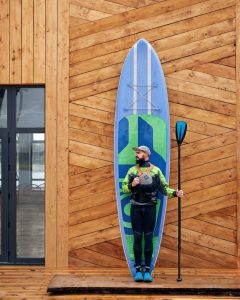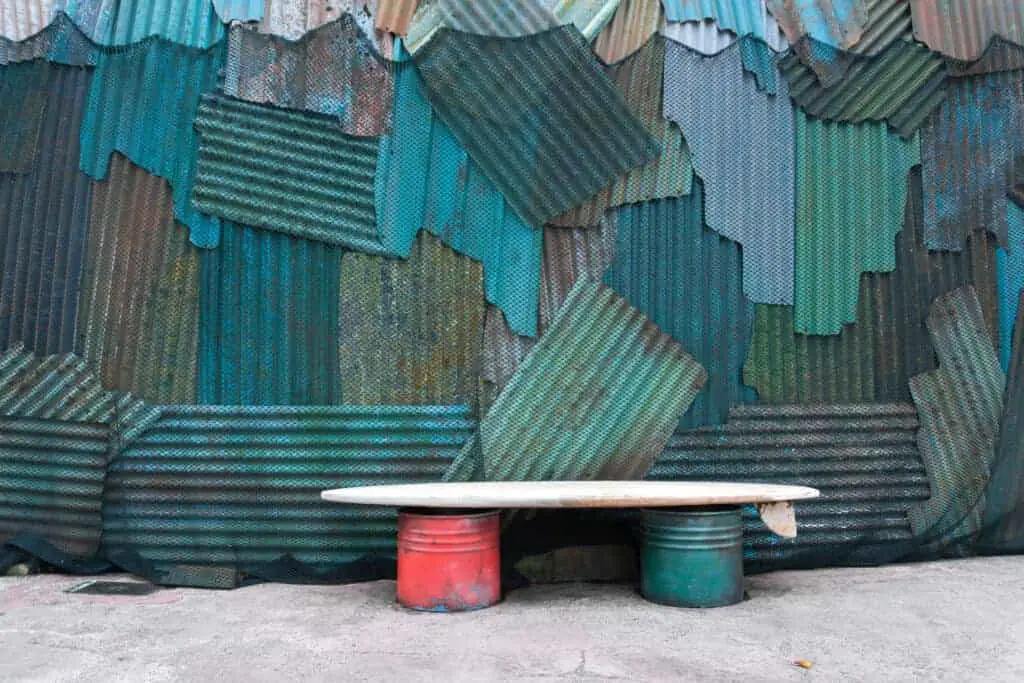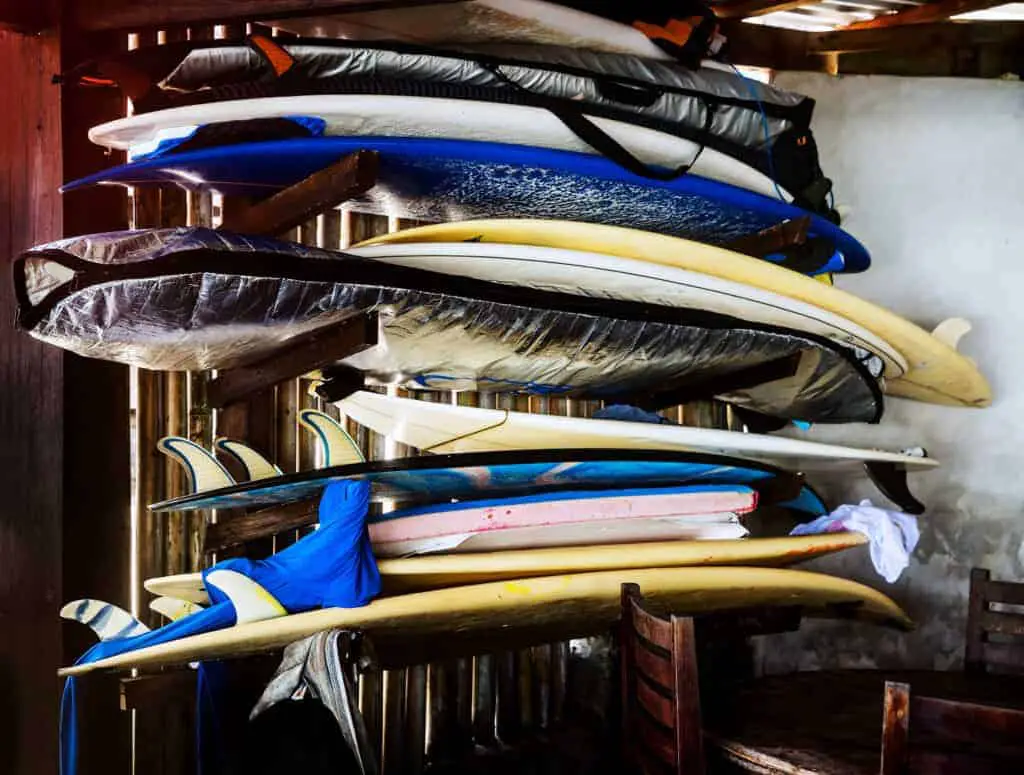Warm weather is usually the highlight for any stand-up paddleboarder as it means spending a lot of time in the great outdoors on the water. Whether by yourself or with friends or family, stand-up paddleboarding season can be the most fun time of the year. While stand-up paddleboarding can be a winter activity, you are more likely to need to store your board during the colder months.
When storing a stand-up paddleboard, make sure to keep it away from moisture, sunlight, and extreme heat. Distribute the board’s weight evenly in whatever position it’s stored in. A paddleboard can be stored on a rack, mounted to the wall, or leaning against a wall.
While there are many ways to store a paddleboard, it is really important to know how to properly store it in any of these ways. We will tell you all of the steps you need to take when storing a stand-up paddleboard in any location. Keep reading to find out how to store your paddleboard.
Before You Store

While the place that you store your paddleboard is one of the most important parts of safely storing your board, there are some things you need to do before putting it up for the winter. These important steps, if done properly, will help preserve your board when you’re not using it so that it will be in tip-top shape for you to get back on the water in a few months.
Before you put up your stand-up paddleboard for a while, follow these steps to ensure it will stay in the best condition it can be in.
- Remove the fin. While a stand-up paddleboard can be stored with the fin still attached, removing it and storing it separately is better. Whether you are going to store it separately or leave it on, you should still remove the fin before following the other steps. Storing the fin separately will protect it from warping while accidentally pushing against a surface for a long time. It will also better protect the fin box and vent from long-term moisture damage.
- Wash your board. After removing the fin from your paddleboard, you need to wash your paddleboard with fresh, clean water. The board needs to be free of any dirt, grime, and salt before putting it away. With a hose, rinse the board off while scrubbing away any spots of grime or rough salty spots. Make sure it is spotless and feels smooth and clean. Removing the fin before this step allows you to clean in the fin box and make sure no dirt gets trapped in there. You should also clean the separated fin in the same way.
- Thoroughly dry the board. Arguably the most important step in preparing to store your paddleboard is making sure the board is dry. Water damage is a real problem in all sorts of situations, and stand-up paddleboards are no exception. Any water hiding in crevices on a paddleboard can cause mold or warping if it is serious enough. Dry off all of the flat areas completely, switching to dry parts of the towel often. With a microfiber towel or a new cotton towel, wipe any water out of smaller areas like the edges of the deck pad, the handle, and the fin box. Make sure to dry the detached fin all the way as well.
- Remove internal moisture. This step is for inflatable SUP owners. Because of their hollow nature, inflatable stand-up paddleboards can have remaining water on the inside of them. This is often a culprit for causing water damage even if the outside of the board is dry. To clear out the water inside the board, lock the air valve so that it will stay open. With a pump or a vacuum, blow air into the open valve until all of the water has been cleared out.
- Re-attach the fin/store the fin. While it is often better to store the board without the fin, like mentioned previously, you can leave it on if you wish. After following all of the steps, you can attach the fin to the fin box again. If you wish to store it separately, it is a good idea to store it with the paddle so that you do not lose it or forget where you put it.
Storing Indoors
Storing a paddleboard indoors is a perfectly reasonable thing to do, especially if you do not have a garage or safe outdoor space. If you live in a large enough apartment with 10-12 feet of vertical or horizontal space against a wall, you can store your SUP indoors.
There are two very common ways of storing a stand-up paddleboard indoors, and one less common but just as doable way as well that we will cover. Horizontally, vertically, and flat over two raised surfaces are the most common ways.
Horizontally
When storing a stand-up paddleboard horizontally, it is most common to lean it against a wall. This way there is even pressure along the whole board. It is relatively out of the way and can be placed behind couches, beds, and other furniture if there is no spare room for it. You just have to make sure that the piece of furniture is pulled away from the wall a little bit so that the board is not crushed. Make sure to have some sort of padding under the board when storing it this way to prevent damage.
A less easy option of storing your board is to install a rack on the wall and hang the board higher up but still horizontal. This is possible and people do it, but if you are planning on moving apartments soon or often then it might be a better idea for when you live in a more permanent place.

Vertically
A stand-up paddleboard can be stored vertically, and this is a pretty common way of storing it indoors. This way the board takes up much less horizontal space, but you do need pretty tall ceilings, 10-12 feet high, to fit the board. If you do store it this way, make sure to only place it on its tail end. Putting it on the nose can be too much pressure and can bend the board over a long period of time.
Like storing the board horizontally, make sure that there is plenty of padding between the board and the floor. With more weight over a smaller surface area, it is even more important to have a soft, stable surface to rest on.
The least common way of storing a paddleboard indoors is by putting it over two crates or supports to create a table structure. Some people like to do this because then it serves a function while not in use and looks cool. If you do this, you need to have plenty of horizontal space in the room for it and you should put some sort of covering over it so that it does not get damaged. If you decide to store this way, make sure the board is very secure and will not fall.
Flat
There are a lot of benefits to storing indoors. You have a cool piece that can be used for decor in your apartment, you will know that it is safe from theft, and the weather will not damage your board. While all of these are great perks to storing the board indoors, this is not always a viable option. If you cannot store your stand-up paddleboard indoors or you don’t want to, you should consider the option of storing it outside or in a garage or storage unit.
Storing Outside
Many people store their paddleboards outside, and it is a perfectly safe way of storing them as long as the proper measures are taken to avoid weather and sun damage.
There are two important steps to storing a paddleboard outside: keep the board off the ground, and cover the board. There are many ways to meet these requirements so there is an option for everyone. These two steps will keep the board, or boards, as safe as possible during a harsh winter or brutally hot summer.
Keep It Off the Ground
The first step is keeping the board off the ground. This is so important, as it is the prime step to keeping it from getting wet and having moisture damage. If a board is on the ground, it is subject to rain or snow.

Ideally, you should put your board or boards up on a rack to keep them off the ground and distribute weight evenly, but if you do not have one, milk crates or sawhorses from a hardware store work very well. Whatever you have to use, just keep the board off the ground!
Cover It
The second step to safely storing a stand-up paddleboard outside is to cover it. The simplest and cheapest way to do this is with a tarp. A tarp is waterproof and will keep any falling rain or snow from getting your board wet. Paddleboards are often damaged by the sun when stored outside without a cover, so a simple tarp helps with that greatly. Make sure to secure the tarp down with as few gaps around the edges as possible so that it does not move during winter storms.
You can also store your paddleboard under an awning that provides decent shade. If you do store it like this, make sure that you cover your paddleboard with a tarp during any bad weather anyway so that it does not get wet.
While it might seem dangerous to your board to store it outside in the winter, many people do it, and as long as you are careful, your board will be perfectly safe the whole winter.
Storing in a Garage
If you don’t want to store your SUP indoors or outdoors, you have the option of storing it in a garage or storage unit. This can be a climate-controlled storage unit that you rent for the winter, or in your garage at home. There are a lot of ways to store paddleboards in a garage in addition to how you can lean them against the wall, like indoor storing. You can store a paddleboard in a garage by hanging it on the wall or on the ceiling.
Wall Storage
There are a couple of popular ways to store a stand-up paddleboard on the wall in a garage. One of these ways is with a wall mount for a single paddleboard. You can install more than one wall mount if you have more than one board, though this method of storage is often better for those that only own one or two boards. Wall mounts keep the board as flat to the wall as possible without crushing it. They keep the boards off the ground and out of the way so that there is plenty of space for storing other things.
The other way to store a paddleboard on a wall in a garage is with a wall rack. A rack is different from a mount in a few ways. A wall rack is meant for people that have more than two paddleboards, as they usually have 3-5 slots for boards. While the wall mount has the boards laying flat against the wall, a wall rack has the boards laying flat and at a slight angle. They stick out more with this way of storing them.

Ceiling Storage
Ceiling storage is a popular way of storing paddleboards, especially if you do not need to access them often. They are perfect for long months of storing your board and keeping it well out of the way. The best way to store SUP’s on the ceiling is with a ceiling rack. These are bolted to the ceiling of a garage and have 1-2 spaces for paddleboards to lay flat. A ceiling rack is great for keeping the boards away from any sort of moisture or sun damage, and it keeps them out of the way.
